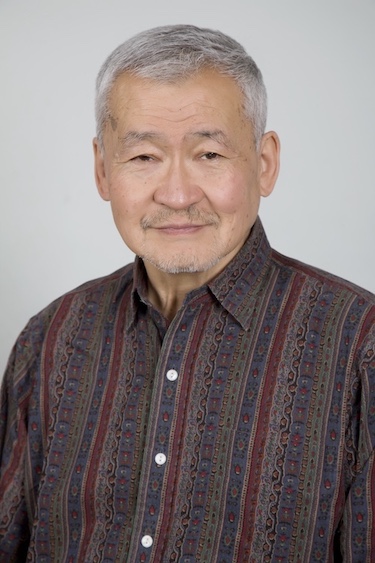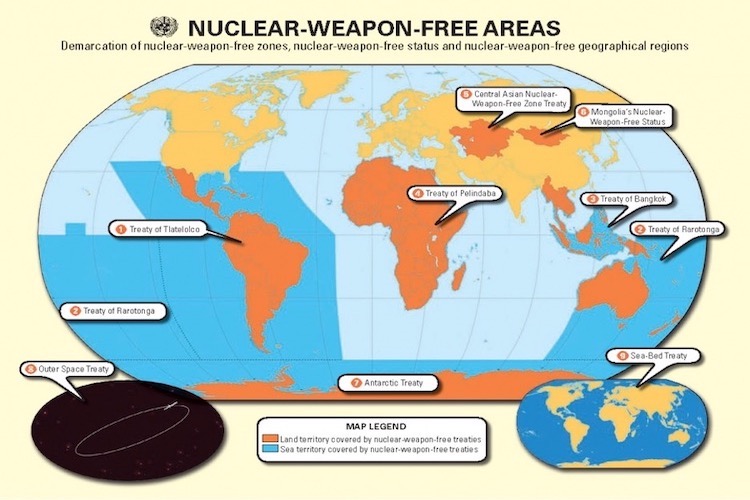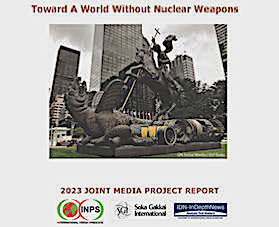Growing importance of NWFZs
Viewpoint by Dr. J. Enkhsaikhan
The writer is Chairman of Blue Banner NGO and Former Permanent Representative of Mongolia to the United Nations
ULAANBAATAR, 5 June 2023 (IDN) — Nuclear-weapon-free zones (NWFZs) are important and practical regional measures of non-nuclear-weapon states (NNWSs) in promoting the goals of nuclear non-proliferation and strengthening confidence among states. (P08) CHINESE | JAPANESE | RUSSIAN
At present there are five NWFZs in inhabited areas: in Latin America and the Caribbean, the South Pacific, Southeast Asia, the entire African continent and Central Asia. They include nearly 120 states that make up 60% of the membership of the United Nations. Establishment of a Weapons of Mass Destruction Free Zone in the Middle East is currently under discussion, as well as informal discussions are underway to establish NWFZs in Northeast Asia and the Arctic. Such zones are based on the concept of group state zones, meaning that only groups of states can establish such zones, which is known as ttraditional zones.
< Dr. J. Enkhsaikhan
However, individual states that due to their geographical location or for some valid political or legal reasons cannot be part of traditional zones, if left excluded from the NWFZ regime could become the Achilles’s heel of the regime by creating blind spots and grey areas in the nuclear-weapon-free world (NWFW) that we are all trying to establish ever since almost the time of establishment of the United Nations. Progress is slow yet being made as evidenced by the entry into force of the Treaty on the Prohibition of Nuclear Weapons.
Time to protect the nuclear Achilles’ heel of the NWFW
A weak NWFZ system is in on one’s interest, while a viable system would surely strengthen the non-proliferation regime. A robust NWFZ regime would be only as strong as its weakest links. Therefore, making NWFZs inclusive of individual states by recognizing the role and status of single-State zones would not only safeguard their interests but also serve as an additional political tool to furthering the objective of the NWFW.
Blue Banner’s[1] recent study has revealed that even with the establishment of additional traditional zones mentioned above, territorial coverage of NWFZs will not be all-embracing due to the missing links of individual states and territories they cover that far exceed for example Central Asian or Southeast Asian zones. The reason is that the current zones are established “on the basis of the arrangements agreed upon by the states of the region concerned”.[2] In today’s interconnected world the role of individual states should not be underestimated either way.
Thus, disregarding the security interests of individual states, especially when great power rivalry is again on the rise, including in the Western Pacific, and the resulting rising pressures to use such states as pawns or their location in their rivalry would surely affect strategic stability.
On the other hand, if single-State zones are recognized and protected by international law they could serve as indispensable building blocks in establishing the NWFW. The study showed that there are nearly two dozen states, including neutral states and some non-self-governing territories that cannot be part of traditional zones.
From international legal standpoint excluding knowingly some NNWSs from the emerging NWFZ regime would be a violation of the spirit of the UN Charter, principles of sovereign equality of states, equal and legitimate security for all, right of states to individual or collective self-defense, etc.
International law needs to regulate their status and protect them like the traditional zones. In all fairness it should be pointed out that it is up to every individual state, based on its sovereign decision to decide whether to make use of such political or legal protection or find other ways to promote its security interests.
Today when time, space and technology are becoming major geopolitical factors and the nuclear arms race is on the rise again this time taking ominous technological dimensions, nuclear weapon states should not use their weapons beyond their declared nuclear deterrence policies as political instruments of intimidation and blackmail even against NNWSs.
Therefore, the states that cannot be part of traditional zones need to adopt national legislations outlawing stationing of nuclear weapons or hosting nuclear weapons use support facilities on their territory and in return acquire appropriate security assurances from the P5. ‘Appropriate’ means an assurance against possible credible threats to the security interests of that particular individual state. The assurance does not necessarily have to be legally binding on non-use or threat of use of nuclear weapons against them as have been the cases with traditional zones during and after the past cold war period.
The P5 assurance should be against pressuring to accept nuclear weapons or hosting nuclear weapons use support facilities for more effective use of such weapons and respect their statuses as reflected in their legislation and not to contribute to any act that would violate the status.
Compared to traditional assurance this would be somewhat softer one known in literature as security assurances lite. A system of verification can be developed with the assistance of the IAEA, lessons learned when establishing traditional zones or by establishing mutually agreed verification mechanism based on the latest technological achievements in the field.
The above stated leads to conclude that the second comprehensive study of NWFZs in all their aspects needs to be undertaken with the participation of all states, and not just some designated ones as it was the case with the first study in 1975.
The study, proposed by Mongolia ten years ago at the United Nations High—Level Meeting on Nuclear Disarmament, should make use of the nearly half a century of the rich international experience of establishing NWFZs as well as the changing international political environment. Such a study would be useful in establishing the second generation[3] traditional zones in the Middle East, Northeast Asia or the Arctic.
The study should also address and recognize single-State zones by broadening the concept and definition of NWFZs as well as agreeing on the content and form of assurances to be provided to single-State zones. The content of P5 security assurances provided to traditional zones needs to reflect the originally intended goal, without distorting it by making reservations or unilateral interpretative statements that in fact serve as indirect indication on the possible use of nuclear weapons.
Sensitive political issues and taboos such as existing double standards, the role of umbrella states, the status of nuclear armed states and their possible role, if any, in the regions concerned should also be addressed. In short un-tapping of the full potential of NWFZs and protecting the Achilles’ heel of the NWFW would be a practical contribution of NNWSs to strengthening world peace and stability. [IDN-InDepthNews]
Image: Visual illustration of the nuclear-weapon-free zones. Source: UN Office for Disarmament Affairs
[1] Mongolian NGO established in 2005 devoted to promoting the common goals of nuclear non-proliferation and disarmament.
[2] Para. 60. UNGA Official Records. Tenth Special Session. Supplement 4 (A/S-10/4). New York. 1978
[3] Second generation zones means NWFZs in regions have their own problems or where strategic interests of nuclear weapon states are involved making establishment of zones complicated.














